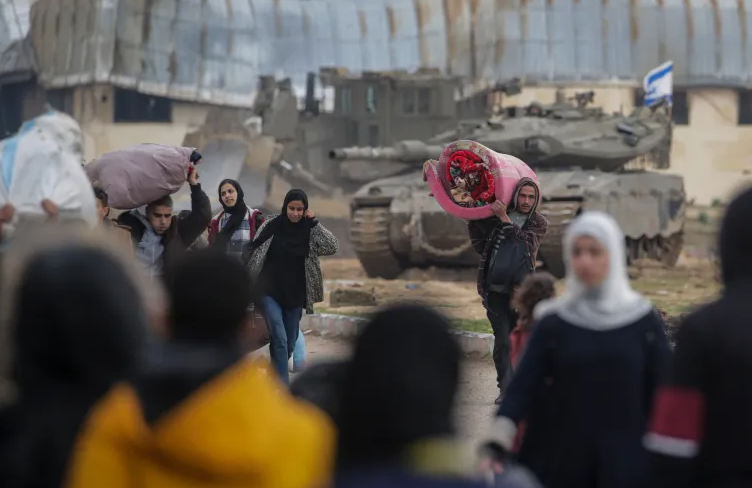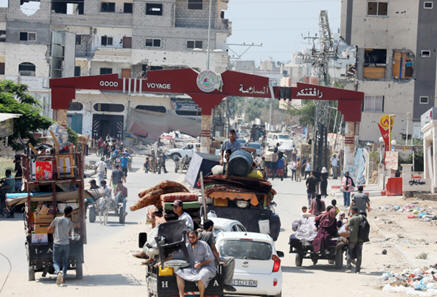www.aljazeerah.info
Opinion Editorials, October 2024
Archives
Mission & Name
Conflict Terminology
Editorials
Gaza Holocaust
Gulf War
Isdood
Islam
News
News Photos
Opinion Editorials
US Foreign Policy (Dr. El-Najjar's Articles)
www.aljazeerah.info
One year of Devastation: Gaza's Ongoing Struggle for Survival, Under the Israeli Genocidal War By Bassam Abu Al-Rob Translated by M.N. Wafa, October 3, 2024 |
 |
 |
 |
| During a break, Palestinian families leaving their neighborhoods, which were destroyed by the Israeli genocidal air strikes on various parts of the Gaza Strip, file, October 3, 2024. | Palestinians from Al-Maghazi, in central Gaza Strip, leaving their neighborhoods, escaping the Israeli genocidal air strikes, file, October 3, 2024. |
One year of devastation: Gaza's ongoing struggle for survival
As the one-year mark of the Israeli genocidal onslaught on Gaza approaches, the scale of devastation is staggering. Over 42,000 lives have been lost, with the majority being children and women, according to the Palestinian Ministry of Health. The humanitarian crisis has spiraled, with approximately 96,000 individuals injured and an entire healthcare and education infrastructure in ruins.
The United Nations Office for the Coordination of Humanitarian Affairs (OCHA) reports that more than 70,000 housing units have been destroyed, leaving around 1.9 million people displaced. The once-bustling streets of Gaza are now a haunting reminder of what was lost.
Destruction of infrastructure and the health system in Gaza
The Ministry of Health's periodic reports confirm that the escalating atrocities in Palestine due to the Israeli aggression surpass mere numerical reports and constitute serious violations of all human rights. The health system is being systematically targeted, amounting to genocide against the Palestinian people.
As of October 2, 2024, the total number of victims has reached 41,689, including more than 11,355 children, 6,297 women, and 2,955 elderly individuals. The number of missing persons stands at around 10,000, while approximately 96,625 citizens have been injured, many suffering from severe trauma and life-threatening conditions.
The Ministry of Health notes that only 15 out of 36 hospitals in Gaza are operational, and all are working partially and facing severe shortages. The occupation has destroyed and burned 32 hospitals in the sector, rendering them out of service.
The ministry also indicates that around 986 health workers have been killed, while the occupation has detained 310 others, injuring hundreds. Additionally, the Israeli occupation forces have destroyed 130 ambulances. The intentional targeting of medical infrastructure has denied civilians access to basic healthcare services, with over 340 attacks on healthcare facilities and their workers.
The ministry states that Gaza is facing a health disaster due to the lack of safe water resources, overcrowding, and insufficient basic hygiene needs. The overflow of sewage and the accumulation of waste in the streets and around shelters for the displaced pose significant public health risks. Furthermore, fuel shortages exacerbate the situation, hindering the operation of essential services.
Gaza exhausted and starving: Ongoing displacement
The United Nations Relief and Works Agency for Palestine Refugees in the Near East (UNRWA) states that "under conditions of forced displacement, difficult circumstances, and extreme heat, families in Gaza are exhausted and hungry, lacking what they need to survive."
Louise Wateridge, UNRWA's communications officer, emphasized in a press statement that "there are many who are desperate, hungry, and tired" due to the ongoing Israeli aggression against the sector. She added that "under forced displacement and harsh living conditions, families in Gaza are worn out and lack what they need to stay alive."
The UN Office for the Coordination of Humanitarian Affairs (OCHA) confirmed that "issuing (by the occupation) orders for mass evacuations in the Gaza Strip without ensuring safe places for the displaced exacerbates the already dire humanitarian situation for hundreds of thousands of people."
In this context, an international report warned in late June of the ongoing high risk of famine throughout Gaza due to the continuation of the war and restrictions on humanitarian access. The report stated that nearly 96% of Gaza's population (2.1 million people) faces high levels of acute food insecurity, with this situation expected to persist until September 2024.
The Integrated Food Security Phase Classification report classified the entire Gaza Strip as being in an emergency state, which is the fourth phase of classification preceding famine (the fifth phase). The report noted that over 495,000 people (22% of the population) face catastrophic levels of acute food insecurity in the fifth phase, where families experience severe food shortages, starvation, and exhaustion of their coping capacities.
As a result of these conditions, which have led to malnutrition, dehydration, and a lack of medical supplies, more than 36 children have died, and dozens continue to suffer from malnutrition and starvation, especially in the northern sector.
$18.5 billion in damage to critical infrastructure in Gaza
In a joint report by the World Bank and the United Nations, prepared with financial support from the European Union, the estimated cost of damage to buildings and critical infrastructure in the Gaza Strip is around $18.5 billion, equivalent to 97% of the total GDP of the West Bank and Gaza combined for 2022.
The World Bank stated that the "Interim Damage Assessment" report used remote data collection sources to estimate the damage to physical infrastructure in critical sectors between October 2023 and the end of January 2024.
The report concludes that the damage to facilities and infrastructure affects all sectors of the economy, with residential buildings accounting for 72% of the cost, while public service infrastructure such as water, health, and education accounts for 19%. Damage to commercial and industrial buildings makes up 9% of this cost.
The statement indicated that "the rate of damage seems to have reached a plateau for many sectors, with few assets remaining intact. The destruction has left an immense amount of debris estimated at around 26 million tons, which may take years to clear and dispose of."
It was added that women, children, the elderly, and individuals with disabilities have faced the most significant cumulative catastrophic effects on their physical, mental, and psychological health, with expectations that younger children will face consequences that will affect their growth and development for the rest of their lives.
The UN report notes that with 84% of hospitals and health facilities damaged or destroyed, and with a lack of electricity and water to operate those that remain, the population receives only minimal healthcare or life-saving medications.
Additionally, the water and sanitation system is on the verge of collapse, providing less than 5% of its previous services, forcing residents to rely on extremely limited water rations to survive. The education system has also collapsed, with 100% of children out of school.
The report also highlights the impact on electricity networks and solar energy production systems, noting near-complete power outages since the first week of the aggression. With 92% of major roads destroyed or disabled and the deterioration of communication infrastructure, delivering essential humanitarian aid to the population has become exceedingly difficult.
According to the report, a rapid and comprehensive assessment of damages and needs will be conducted to fully estimate economic and social losses, as well as the financing needs for recovery and reconstruction. The estimated costs of damages, losses, and needs through the comprehensive rapid assessment are expected to be much higher than the costs of the interim damage assessment.
In late September, the UN Satellite Center issued the ninth update of its assessment of damage to buildings in the Gaza Strip, showing that two-thirds of all buildings in the sector have been damaged.
The analysis is based on high-resolution satellite images collected on September 3 and 6, 2024. The center compared the images taken on those two days with previous data, providing a comprehensive view of the extent of the destruction.
The center reported that 66% of the damaged buildings in the Gaza Strip include a total of 163,778 buildings, including 52,564 that were destroyed, 18,913 that were severely damaged, 35,591 that may have been damaged, and 56,710 that were moderately damaged.
The analysis results indicate that the most affected area overall is the Governorate of Gaza, where 46,370 buildings have been damaged. The city of Gaza has been notably affected, with 36,611 buildings destroyed.
The UN Satellite Center (UNOSAT), in cooperation with the Food and Agriculture Organization (FAO), also released an update on the health and density of agricultural land in the Gaza Strip, finding that approximately 68% of permanent crop fields in the sector showed significant declines in health and density as of September 2024.
397 schools and universities completely or partially destroyed
According to the Ministry of Education and Higher Education, 124 government schools have sustained severe damage due to the war on the Gaza Strip, with more than 62 government schools completely destroyed and 126 government schools subjected to bombing and vandalism.
Additionally, 65 schools belonging to UNRWA have been bombed and vandalized, while 20 higher education institutions have sustained severe damage. Over 35 university buildings have been completely destroyed, and 57 university buildings have been partially destroyed.
The ministry recorded the murder of more than 10,317 students and injuries to over 16,119 others since the outbreak of the war on the Gaza Strip, while 416 educational staff members have been martyred, and more than 2,463 teachers from schools and universities have been injured.
The genocide has prevented 39,000 students from sitting for their Tawjihi high-school exams, either because hundreds of them became victims of the aggression or due to their interruption in education caused by the war and the comprehensive destruction of the educational process.
***
|
|
|
|
||
|
||||||


